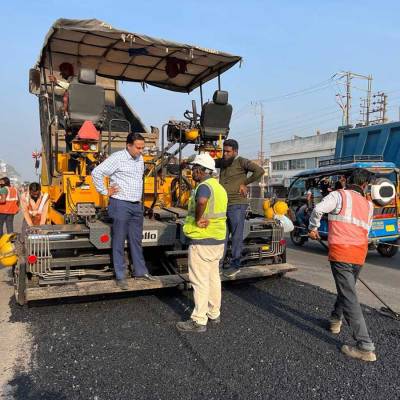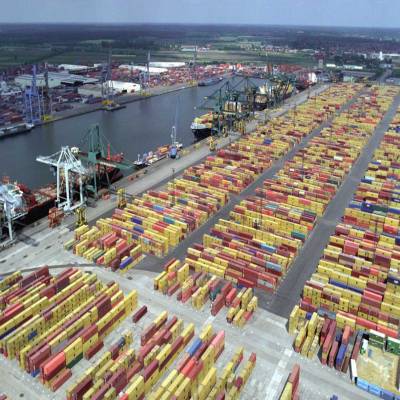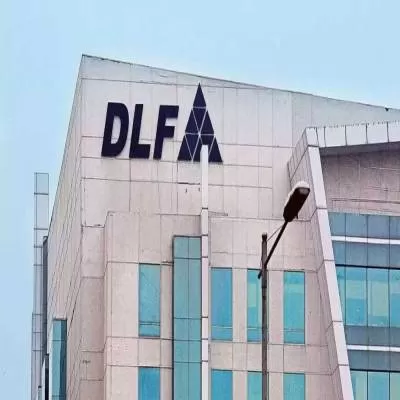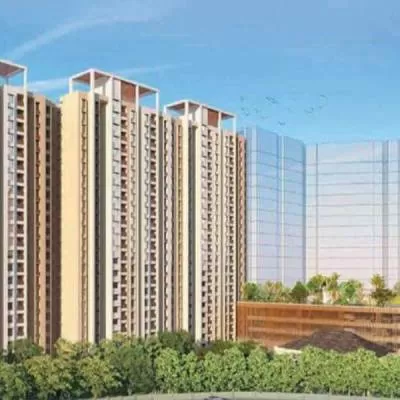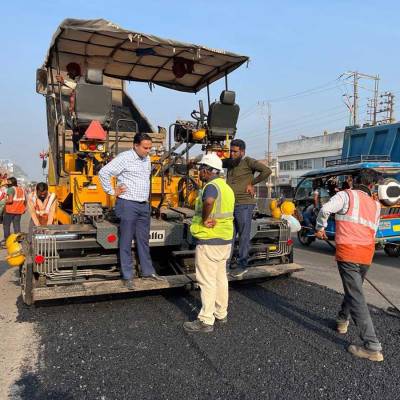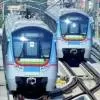- Home
- Real Estate
- Can We Cure Project Paralysis?
Can We Cure Project Paralysis?
Read full article
CW Gold Benefits
- Weekly Industry Updates
- Industry Feature Stories
- Premium Newsletter Access
- Building Material Prices (weekly) + trends/analysis
- Best Stories from our sister publications - Indian Cement Review, Equipment India, Infrastructure Today
- Sector focused Research Reports
- Sector Wise Updates (infrastructure, cement, equipment & construction) + trend analysis
- Exclusive text & video interviews
- Digital Delivery
- Financial Data for publically listed companies + Analysis
- Preconceptual Projects in the pipeline PAN India
- CW
- Infrastructure projects
- MoSPI
- Vijay Agrawal
- Equirus Capital
- Shubham Jain
- ICRA
- PPP projects
- Siva Subramanian
- Fitch GrouP
- Mission PRAGATI
- Railways and hydropower
- Kaleshwaram Lift Irrigation Project
- Neeraj Vijay
- Chetak Enterprises
- Sudhir Hoshing
- IRB Infrastructure Developers
- LARR
- K Jalandhar Reddy
- KNR Constructions
- NHAI
- EPC
- Bharatmala Pariyojana
- National Highways
- Arun Goyal
- Project Monitoring Group
- State Pollution Control Board
- PRAGATI
CW identifies challenges impeding project execution leading to time and cost overruns, and probes into possible solutions. Of 1,698 central-sector infrastructure projects worth Rs.1.50 billion and above, 578 projects have reported time escalations (or, in other words, delays), 400 projects reported cost overruns and 202 projects reported both time and cost overruns with respect to their original project implementation schedules, while 374 are on schedule, as in November 2019, according to the Ministry of Statistics and Programme Implementation (MoSPI). About 93 projects have reported additional delays vis-à-vis their date of completion reported in the previous month (October 2019). Of these 93 projects, 26 are mega projects worth `10 billion and above.In November 2019, the total original cost of implementation of the 1,698 projects was Rs.20.41 trillion and their anticipated completion cost is likely to be Rs.24.41 trillion, reflecting overall cost overruns of Rs.4 trillion (19.63 per cent of the original cost). The expenditure incurred on these projects till November 2019 is Rs.10.50 trillion, which is 43.01 per cent of the anticipated cost of the projects. (Scan the QR code here for the full report).However, the number of delayed projects decreases to 484 if delay is calculated on the basis of the latest schedule of completion. Further, for 728 projects, neither the year of commissioning nor the tentative gestation period has been reported. Of 578 delayed projects, 190 (32.87 per cent) projects are experiencing an overall delay in the range of one to 12 months, 121 (20.93 per cent) projects in the range of 13-24 months, 146 (25.26 per cent) projects in the range of 25-60 months and 121 (20.93 per cent) are experiencing a delay of 61 months and above. The average time overrun in these 578 delayed projects is 38.84 months.Our story in the January 2019 edition highlighted that of 1,420 similar projects, 385 were then on schedule, 366 projects delayed, 358 projects reported cost overruns, and 136 projects reported both time and cost overruns with respect to their original schedules. The number of delayed projects has evidently increased since then. Why the delay?The major bottlenecks are delay in land acquisition, litigation, clearances from authorities, local agitation, execution delays by the contractor, poor project planning and monitoring, geological surprises, and inadequate funding and estimates. (See box on ‘Unavoidable bottlenecks faced by mega contractors.’)“In India, litigations are the main cause of delay in completion of infrastructure projects,” says Vijay Agrawal, Executive Director, Equirus Capital. “These may be related to land acquisition, environmental impact or local groups affected by projects. We have witnessed delays of 5-10 years in most cases owing to litigations.” He cites the example of Hyderabad Airport being delayed by over three years because of litigation for environment reasons. He believes that delays owing to land acquisition, permissions, project planning and monitoring can be avoided by proper coordination between various government departments. The delay in payment to contractors is another problem, he adds.Besides land acquisition, obtaining clearances and funding tie-ups, Shubham Jain, Group Head & Senior Vice President, Corporate Ratings, ICRA, points to shifting of utilities, removal of encroachment, geological surprises during execution stage and change in scope that take considerable time.Generally, the government’s efforts in addressing project delays are become increasingly proactive, notably in PPP projects, notes Siva Subramanian, Director, Infrastructure & Project Finance, India Ratings & Research (Fitch Group). MoSPI’s report is specific to central-sector projects; some of these are large in value and include atomic energy, metro-rail, rail connectivity and LPG pipelines. “These projects require significant coordination between various agencies. The trend indicates cost overruns of 17-20 per cent on central-sector projects from June 2018.”In March 2015, the PRAGATI (Pro-Active Governance And Timely Implementation) platform was announced by the government. So far, a total of 269 projects with a total investment of Rs.12.30 trillion have been reviewed under the government’s PRAGATI platform. (For more, see box on ‘Mission PRAGATI’.) Where’s the delay?Timely completion is contingent on the availability of approvals, right of way (RoW) and prompt project funding. While the first two are in the concession granter’s hand, funding is a function of project debt viability and the financial position of equity sponsors. “Among the rated universe of projects, the least delays are seen in renewable projects and interstate transmission assets,” observes Subramanian, “while highway and urban development projects see considerable delays.” The plug-and-play model being spoken in Budget speeches is yet to take shape!In terms of key segments, railways and hydropower have witnessed the maximum delayed projects, whereas National Highways have done relatively better, according to Jain. “Railway projects face delays because of land acquisition, design approvals, etc.” Many large projects in this sector have been ongoing for over a decade and costs have increased manifold. “Hydropower projects are prone to high geological risks and challenging execution, which often result in large delays in implementation and major cost overruns.” Agrawal points to irrigation projects seeing maximum delays as well, because of geological surprises and inadequate funding – many have seen delays of over 10-15 years. “Better planning and funding can reduce such delays,” he avers. He cites the Kaleshwaram Lift Irrigation Project executed by the Telangana Government, which was executed within estimated timelines and budget. In his view, solar projects, telecom and airports have seen least delays. “Most of these projects are executed in a secluded area after land acquisition,” he explains. “Hence, government agencies and contractors have better control over project execution.” The stand required on landDelay in land acquisition is known to be a key reason affecting project execution.“The government should not advertise until it has 80 per cent of land for a project in possession,” emphasises Neeraj Vijay, Director, Chetak Enterprises. “To bid the project in a hurry, it usually notifies that 80 per cent land is available. But the notification of acquiring land, and land actually in possession, are two different things. If a project is bid out after possession, there will be less arbitration and fewer compensation cases, and less extension of buying and faster execution of projects.”Here, Sudhir Hoshing, Joint Managing Director, IRB Infrastructure Developers, notes, “If land is made available and utilities to be shifted are identified in time, I don’t think any major issues will remain. Yes, in certain states, there are issues of mining of sand, aggregates, etc; there are also no clear guidelines of royalty payments of such excavated materials. The authorities should ensure enough raw materials are available for building roads. In case any state has a peculiar requirement, it should be mentioned in the DPR and the cost of such items must be included in the project cost.”The amendment of the Land Acquisition, Rehabilitation and Resettlement Act (LARR) 2013 was based on the premise that it would help stalled infrastructure projects to recommence. “According to the recent Economic Survey, of over 80 per cent of stalled projects, only 15 per cent were owing to issues in land acquisition,” K Jalandhar Reddy, Executive Director, KNR Constructions, points out. “The rest were stuck because of lack of funds, arriving at adequate compensation, land ownership, title, link documents, or other bottlenecks particular to the region. Hence, providing adequate funds and other remedial measures for the above will speed up land acquisition.”Highway projects: No work orders till 80-90% land is acquired?Reports indicate that the NHAI will not issue work orders for highway projects under the PPP mode unless 90 per cent of the land is acquired and all statutory clearances obtained. Currently, projects can be awarded even with a lower amount of available land, says Jain, although there is a provision that the appointed date is to be fixed only after availability of 80 per cent RoW for HAM and 90 per cent for EPC. “Having said that, this can result in delay in appointed date after the award of the project if there is a delay in acquisition of the minimum required land. If the proposal of awarding projects only once 90 per cent of land and all clearances are in place is implemented, project execution can start quickly after award and overall execution pace will improve. Besides, streamlining utilities shifting and removal of encroachments can help in faster execution.”Under HAM, the concession grantor aims to handover the project and issue the appointed date only after 80 per cent of land availability and the model allows scope reduction for the unavailable portion if it continues to be a challenge. “Developers are proactively seeking 3H (completion of land acquisition process, wherein land owners compensations are paid) for 80 per cent of the land prior to acceptance of the appointed date; there is significant delay seen in receipt of the balance portion,” says Subramanian. “As the de-scoping provisions of the concession agreements are not been adhered to, many projects are now lagging. While 90 per cent of land is required for EPC projects as payment is made on milestone payments, the impact is not equivalent to projects under HAM. Receipt of timely approvals and land and adhering to de-scoping provisions are critical to ensure timely and smoother completion of projects.” He points to the solar park model where the evacuation infrastructure and land made available upfront for construction could hasten project execution. A similar approach for other PPP projects would help bring time overruns under control.Agrawal believes the move will expedite project execution and avoid cost overruns and delays. “NHAI will benefit by way of achievement of execution targets. Contractors will also benefit by way of timely execution within cost. However, this may delay award of projects in the interim period till land acquisition is done.”Delay in appointed datesIn FY2018-19, 5,493 km of National Highways were awarded, which was 67.8 per cent lower than the 17,055 km awarded during the previous year. Further, the project award target has been reduced to 6,000 km for FY2019-20 from 20,000 km for FY2018-19.Under Bharatmala Pariyojana, the government awarded 178 projects with an aggregate length of 7,998 km till March 2019, a mere 23 per cent of the planned length of 34,800 km. As on June 30, 2019, there were 46 projects where the appointed date was due for more than three months. “The delay in awards is mainly on account of delay in obtaining prerequisite land for awarding projects,” says Agrawal. “Further, as on March 31, 2019, there were 1,495 NH projects under construction or in the development stage. Of these, 453 development projects were running behind scheduled timelines owing to delay inland acquisition, utility shifting, non-availability of aggregates, poor performance of contractors, and delay in clearances and approvals.”Most projects awarded in FY2019 are yet to receive the letter of allotment or appointed date. While most projects have received financial closure, “the delay is predominantly attributable to availability of 80 per cent of land to start the project,” says Subramanian. Further, with the NHAI failing to give official approval for the execution of projects, five contractors recently exited eight highway projects. (See box on ‘Why are contractors exiting highway projects?’)Land cost impeding executionBesides the operational challenges in land acquisition, the increasing cost of land has added to the overall burden on the authority or project owner. “Adequate planning and streamlining land acquisition can help to some extent,” says Jain. “NHAI’s plan of issuing land bonds may also help reduce its financial burden related to land acquisition cost to an extent.”Land acquisition is currently handled by the respective concession grantor along with state governments and its cost depends on the location of the stretch. The cost of land acquisition has increased by almost three times in recent years; it continues to hover at about 25-30 per cent of the total capital expenditure for the construction of National Highways, adds Agrawal.As Subramanian informs, The Right to Fair Compensation and Transparency in Rehabilitation & Resettlement Act 2013 was amended in December 2014 to provide higher compensation, resettlement and rehabilitation benefits to landowners. “This, coupled with the process of 3G/3H notification, has led to significant delays in the awarding of the appointed date, which hampers developers from optimally using their resources. Land acquisition is undertaken simultaneously for all projects, leading to significant fund requirement at the same time and delay in acquisition.”Prioritising of projects and focused acquisition targets could enable faster execution. It’s time to get moving and shed the project paralysis!“More than 80 per cent of issues pertained to the state governments.”Arun Goyal, Former Secretary to the Government of India and Ex-Head of the Project Monitoring Group (PMG), had a long stint in the Group from October 2015 to February 2019. PMG was tasked with fast-tracking, setting up and implementing large public, private and public-private partnership (PPP) projects by resolving a variety of issues. The group mainly dealt with projects with anticipated investment above Rs.10 billion ( Rs.5 billion in case of projects with FDI). “The issues uploaded by project proponents on PMG’s portal were resolved through regular review,” says Goyal. “The review was carried through inter-ministerial subgroups and state-level meetings with respective chief secretaries or senior level-officers at state capitals or through video conference. Project proponents were also invited for these review meetings. During my three-and-a-half-years stint at PMG, more than 3,400 issues pertaining to over 720 projects were resolved under the mechanism.” Goyal shares more on solutions to avoid time and cost overruns...“I observed that issues leading to time or cost overruns pertained to both the Centre and state governments. Central Government issues included environment, forest and wildlife clearances; eco-sensitive zone clearances; sanction of debt funds and working capital by banks or financial institutions; approval for private railways siding construction; and permission for road crossing of pipelines, transmission lines, railway lines and shifting of utilities. State government issues included land acquisition issues such as government notifications or disbursement of compensation and mutation; removal of encroachments and handing over possession of land; formulation of relief and rehabilitation plans; issue of certificate under the Forest Rights Act; tree-cutting permissions; grant of right of way (RoW) permissions; consent to establish and operate from the State Pollution Control Board; and transfer of government land.I found that most of the issues on our portal pertained to the Central Government’s linear projects such as highways and rail lines, transmission lines and pipelines. Few issues pertaining to the Central Government were pending on PMG’s portal at a particular time. In the Central Government, rigorous and digital monitoring mechanisms ensured issues were addressed quickly. More than 80 per cent of issues pertained to the state governments. As projects are executed on ground in different states, response varied from state to state. Some states were also slow in responding to issues owing to political reasons.I have observed that once there is cost and time overrun in a public project, project execution tends to get further delayed. In a delayed project, decision-making involves deviations from the terms and conditions of the tender and, at times, the financial implications may be huge. In such circumstances, public-sector executives and civil servants tend be cautious and sometimes the procedures involved are also lengthy. There is another important difference in project execution between the private sector and public sector. A public-sector employee has to follow all procedures of tendering, etc, without consideration of the time and amount already invested into the project. On the other hand, a private-sector executive is able to factor in opportunity and the cost involved because of the amount and time already invested and need not follow all procedures. Overall, I feel there has to be a sense of urgency among state-level officials, particularly at the district level, to proactively resolve and expedite local-level issues. This is particularly important for linear projects because, sometimes, a long, linear project with huge investment may get stalled because of issues involved in a small patch of land.”Mission PRAGATIA total of 269 projects with a total investment of Rs.30 trillion have been reviewed under the government’s PRAGATI platform. This January, Prime Minister Narendra Modi chaired the 32nd interaction of PRAGATI – the ICT-based, multimodal platform for Pro-Active Governance and Timely Implementation, involving the Centre and state governments. Nine delayed projects worth `240 billion were reviewed in the meeting. These projects are spread across nine states: Odisha, Telangana, Maharashtra, Jharkhand, Bihar, Karnataka, Andhra Pradesh, Kerala and Uttar Pradesh – and three Union Territories. The projects include three from the Ministry of Railways, five from the Ministry of Road Transport and Highways, and one from the Ministry of Petroleum and Natural Gas. Further, in the previous 31 PRAGATI interactions, a total of 269 projects with a total investment of `12.30 trillion were reviewed by the Prime Minister. That said, despite CW’s continuous efforts, data on these projects was not made available. Effective mechanism?While the delay saga continues, PRAGATI has helped fast-track of stuck projects, leading to cost and time savings. “Many projects stuck for years have achieved completion, such as the Eastern and Western Peripheral Expressway around Delhi, Pakyong Airport in Sikkim, the Panipat Jalandhar six-lane project and Phase-1 of the Delhi-Meerut Expressway,” observes Vijay Agrawal, Executive Director, Equirus Capital.“The platform has reviewed and taken steps to remove bottlenecks in multiple projects covering an investment of over Rs.12 trillion,” says Shubham Jain, Group Head & Senior Vice President, Corporate Ratings, ICRA. “While it would be difficult to quantify the impact of PRAGATI on project execution, it is certainly a positive initiative that can help resolve bottlenecks in some large projects.”The PRAGATI mechanism for monitoring is an ongoing process. “After its implementation and until March 2018, cost overruns remained under 15 per cent,” according to Siva Subramanian, Director, Infrastructure & Project Finance, India Ratings & Research (Fitch Group). Given that projects are added and dropped over the years, he believes cost overrun is not the only metric to be measured. “Project completion is an important aspect for the assessment of success.”From the perspective of a construction contracting company, Yogesh Kumar Jain, Managing Director, PNC Infratech, says, “PRAGATI is an effective and expedient project-monitoring framework mechanism reviewed monthly at the highest levels of both the Centre and state governments. It is learnt that several big-ticket infrastructure projects that have been stuck for years could be accomplished through this platform during the past five years. A programme of this nature and enormity will instil confidence in any infrastructure implementation company like us in successful delivery of big-ticket projects.”Unavoidable bottlenecks faced by mega contractorsWhile CW connected with several large contractors to understand their project execution challenges, most mega firms refrained from commenting to the subject. However, whether large, medium or small, challenges have been impeding project execution for these construction companies for a while now.“We continue to face timely availability of unencumbered, unobstructed, encroachment-free land for unimpeded construction as the critical challenge in execution of ongoing highway projects,” highlights Yogesh Kumar Jain, Managing Director, PNC Infratech. “However, as the government, including MoRTH and NHAI, had already taken a policy decision that highway projects should not be bid out for selection of contractors and developers for implementation until and unless 80-90 per cent of vacantly possessed land is available for construction, this most prevalent bottleneck is expected to be resolved and remedied going forward.”Timely availability of unencumbered, unobstructed, encroachment-free land for unimpeded construction is a critical challenge in execution of ongoing highway projects.Jayanta Basu, Managing Director, ITD Cementation India, points to other challenges as the right of use or right of way (RoW); geological surprises from the awarded tenders differing with actual execution challenges; and challenges of getting labour gangs. And K Jalandhar Reddy, Executive Director, KNR Constructions, adds that fiscal deterioration, institutional weaknesses and inability to scale up commercial financing of lenders leading to delays in receiving financial closure for HAM projects as well as postponements in the receipt of appointed dates for projects because of land availability are the main bottlenecks. “Land acquisition has been a major issue for projects, where delays lead to receiving appointed date,” he says. “As a result, there is delay in execution and revenue recognition for several developers.”“Good-old land acquisition and utility shifting issues still prevent quick progress at site,” observes Sudhir Hoshing, Joint Managing Director, IRB infrastructure Developers. “Even though now, things are much more in order.”For Neeraj Vijay, Director, Chetak Enterprises, the main challenge is the availability of RoW. “Arranging financial funding is another challenge,” he adds. “Thankfully, our company has been strong in terms of financials and we could arrange all financial closures in time.”Having said that, he points out to land issues being omnipresent. “Land availability is not in our hands. It is the government who has to hand over the land.”Overcoming land acquisition issuesEvidently, land acquisition has become the biggest hindrance across projects. So what efforts are major contractors taking to overcome the same?“Given the major challenge, we had taken widespread proactive measures, adopted multipronged strategies and assumed higher responsibilities than what was envisaged in the contracts to support the authorities in expediting the process of land acquisition and removal of encumbrances,” shares Jain. These concerted efforts made by the company resulted in the declaration of appointed dates and commencement of execution for most of the awarded projects during FY2019. “As a result, there has been a quantum jump in the company’s top-line and bottom-line in FY2019, which is expected to be continued in FY2020 also.”As ITD Cementation India operates only in the EPC scope,“land acquisition is not part of our responsibility,” says Basu. “However, in some of our projects this is one of the hindrances in execution related to our client issues. We work closely with clients to contractually address the impact of time and cost.”Are approvals in place for newly bagged projects?In FY2019-20, PNC Infratech has so far secured four highway projects for an aggregate quoted price of Rs.46 billion, comprising one EPC and three HAM projects of NHAI. “In case of the EPC project, Lucknow Ring Road Package-1, all approvals are in place and the appointed date has been declared with effect from February 7, 2020,” reveals Jain. “In case of the three HAM projects, we have been declared as the L1 and award letters are awaited.”ITD Cementation India has bagged five projects in the tunnelling sector aggregating to a total of RS.34.50 billion; the Myanmar Adani Container Terminal worth Rs.5.60 billion in the marine sector; and a project worth Rs.11.28 billion in the industrial building sector – the redevelopment of General Pool Residential Colony in Kasturba Nagar, New Delhi (Phase-1) for CPWD. “All these projects have commenced and approvals are in place for execution,” shares Basu.Chetak Enterprises recently bagged the 93-km, six-lane Shamla Ji to Motachilodha highway project in Gujarat worth Rs.12.73 billion. “It is about 40 per cent complete, with all the approvals in place,” says Vijay.Since the beginning of FY2019, KNR Constructions has bagged projects and achieved progress in terms of signing concession agreements, achieving appointed dates and financial closures, and monetising a BOT road project. “In the irrigation sector, we have two projects worth Rs.8.50 billion each; the execution work has just commenced for one while we are hoping to execute the other ahead of schedule,” says Reddy. In the highways sector, the company has three projects: A HAM project under Bharatmala in Tamil Nadu worth Rs.9.20 billion, for which it signed the concession agreement in December last year and the financial tie-up is at an advanced stage; a HAM project in Karnataka worth Rs.11.44 billion, for which it achieved the appointed date in February last year; and a comprehensive road maintenance plan in Hyderabad worth Rs.5 billion, for which execution is underway. “We have a portfolio of nine projects, of which five are HAM, two BOT (toll) and two BOT (annuity), and have received appointed dates for four HAM projects. Execution of three NHAI HAM projects is in full swing,” says Reddy. The company’s total order on hand is Rs.65.23 billion.Why are contractors exiting highway projects?With the National Highways Authority of India (NHAI) failing to give official approval for the execution of projects, five contractors have exited eight highway projects (see box). Analysts’ take“The companies estimated abnormal cost increase because of delay and disruption of works. Hence, they decided to exit the projects,” says Vijay Agrawal, Executive Director, Equirus Capital. These companies have exited projects owing to the undue delay in land acquisition. “Developers exhibit confidence on the model during the bidding stage; at the same time, they are cautious when the risks weigh on the return prospects,” says Siva Subramanian, Director, Infrastructure & Project Finance, India Ratings & Research (Fitch Group). “Especially when the set timelines are difficult to be met in providing land, developers express the willingness to exit projects. This approach is safe not only from the developers’ perspective but also for the entire lending ecosystem.” According to India Ratings, land acquisition and right of way (RoW) are the principal reasons for project delays and cost overruns.“After the award of a project, typically, the requisite RoW has to be provided within one year. If the land is not available even after this time, termination may be the best option for both the parties,” says Shubham Jain, Group Head & Senior Vice President, Corporate Ratings, ICRA.The contractors’perspectiveKNR Constructions (KNRCL)Project exited: Meensurutti to Chidambaram According to 10.3.4 of the Concession Agreement, within 90 days of the financial closure, the authorities have to make efforts to declare the appointed date. As per Clause 4.5 of the Concession Agreement, if the appointed date does not occur for want of 80 per cent of RoW before the first anniversary date of the Concession Agreement or extended period available to the authorities, the concessionaire has the right to apply for ‘deemed termination’. “As the land was available in bits and pieces and access was not available in several locations, pursuant to the Clause 4.5 of the Concession Agreement, the concessionaire KNR Chidambaram Infra requested NHAI to take cognizance of the deemed termination of the project,” shares K Jalandhar Reddy, Executive Director, KNRCL.When asked if seeking an appointed or official date for the execution of projects is a challenge faced by construction companies, Reddy shares that many HAM projects are still awaiting appointed dates or the starting date of a project. Delays in land acquisition or regulatory clearances are major hindrances for the developer or concessionaire to commence a project even months after the project has been awarded. He adds, “Second, 46 per cent of HAM projects have gone past the five-month window available for financial closure. The cautious approach and reluctance to lending by banks appears to be the main reason for these delays. Interest of a number of banks (including SBI) in lending to highway projects (HAM and BOT) has come down drastically. Further, some projects in advanced stages of execution are yet to receive the balance RoW, potentially affecting execution and COD.”IRB infrastructure Developers Projects exited: Puducherry to Poondiyankuppam; and Poondiyankuppam to Sattanathapuram “For both projects, IRB could get the financial closure on time but as NHAI could not get the required land on time, the projects reached termination time as per the Concession Agreement guidelines,” shares Sudhir Hoshing, Joint Managing Director, IRB infrastructure Developers. He adds, “Even to date, land acquisition haunts road builders. Although to start the project and get the appointed date, 80 per cent of land is to be made available by the authority, in some cases disputes on actual ownership and payments delays the process of handing over land.” According to him, the best method to avoid delays is to start the process of land acquisition well before time; by the time, financial closure happens, 80 per cent of clear land should be made available.Chetak EnterprisesProject exited: Shimla BypassThe project work was bid out in 2016 and the appointed date was notified in April 2018 but to date, the government has failed to hand over land for the project, shares Neeraj Vijay, Director, Chetak Enterprises. “Further, there was a massive change of scope of work as all the bridges on the highway were initially proposed for two-lanes but we were later asked by NHAI to design for four-lanes. With this change in the scope of work and design, the estimated cost of the project increased from `14.80 billion to `22 billion. For one-and-a-half years thereafter, land was not available for the project. We were answerable to lenders as the appointed date was notified but the project construction had not commenced. The land had about 28,000 trees, of which the forest department could cut only 22,000 trees until December last year. Even a year and a half after the declaration of the appointed date and almost four years of the bid, land was not available and the scope of work was not final. So, we were forced to terminate the project on account of authority default.”He adds that when the appointed date for the Shimla Bypass project was declared, 80 per cent land was not available; even today, it is not available. The firm had already deployed 300+ manpower for a year and a half and Rs.800 million worth of machines. It had also brought international designers from California to design the hi-tech project; signed an agreement with Galadari Engineering, pioneers in the Middle East as far as steel work is concerned; signed an agreement with Tensa from Italy who are leaders in cable-stayed bridges; signed AECOM India and Hong Kong as consultants for the project; and appointed Fugro International for geotech engineering and investigation and IIT-Roorkee for seismic studies. “All this investment has gone waste because the authority was not well prepared and declared the project without proper scope of work,” says Vijay. “Hence, we could not go ahead with the agreement and had to terminate the project.”Five construction companies exit eight projectsSadbhav Infrastructure Project 1) The Visakhapatnam Port Road 2) Bhimaser Junction to Anjar-Bhuj3) Banavara to BettadahalliJV of IRB infrastructure Developers and Modern Road Makers1) Puducherry to Poondiyankuppam2) Poondiyankuppam to SattanathapuramKNR ConstructionsMeensurutti to Chidambaram Chetak EnterprisesShimla BypassOriental Structural EngineersViluppuram to PuducherryRecommendations for successful project implementationSeveral challenges are impeding project execution in a big way, resulting in time and cost overruns. CW lists these based on the industry’sperspective:Judicial activism; poor preplanning and surveys; defective design and DPR; poor monitoring; inadequate financing and funding availability; land acquisition; delays in clearances/approvals and clearance required from numerous interrelated agencies; timely securing of forest clearances, including approvals for tree cutting; shifting of utilities, including existing electric and water supply lines in case of brownfield projects; externally driven conditions through heavy moving traffic with several obstructions of underground and overhead utilities; right of way; funding of HAM projects; change in the scope of works after the DPR is prepared.And, we speak to industry experts to know what can help curb the issues of time and cost overruns for successful project implementation:Shubham Jain: Proper project planning and streamlining approvals can help resolve the challenges to an extent. Also, increasing the avenues of project financing can help improve funding availability at a lower cost for the infrastructure sector, which can, in turn, help in project implementation.Vijay Agrawal: Project implementation can be fast-tracked through: Preplanning and surveys: A detailed on-ground survey of the site by latest technologies such as drones (UAV), LIDAR, etc, can be done before designing the project. Geological conditions of the site can be assessed by carrying out various tests. Integrating these results in preplanning will help better project design and cost estimation.Evaluation of contractors’ capability and project monitoring: A bid can be designed in two stages: Technical evaluation and financial evaluation. This will help select technically qualified contractors for complex jobs. A strong project monitoring system is required to monitor progress with the use of latest technologies like BIM, IoT, drones, etc. Funding of projects: Timely payment to contractors plays a major role in timely completion of projects.Factors that can ensure faster execution of highway projects: Timely settlement of contractors claims towards change of scope and contractual payment; milestone based payment with bonus for early completion and penalty for delays; payment of arbitration claims immediately on receipt of award; increased monitoring of project execution by using technology and digitisation like BIM, etc; revamping of project agreements and improving contract management; proper DPR preparation post site surveys and pre-planning of project; lean construction methods like prefabrication, preassembly, etc, and increased use of new materials and technologies in construction.Siva Subramanian: Construction completion risks outweigh operational risks in HAM projects. In sectors such as renewables, evacuation infrastructure and land availability are major concerns for construction. While the sector is gradually limping back from funding challenges, it is imperative to put in a plug-and-play model for roads, transmission and renewables.Neeraj Vijay: Before advertising, a team from NHAI should visit the site to check every kilometre of the road to ensure the scope of work is not changed once the DPR is prepared. The government should not advertise till it has 80 per cent of the land in possession.Jayanta Basu: Expeditious settlement of contractual claims without getting into legal recourse.Contractual drafting having fair and equitable conditions with plug-and-play models, so that clear work fronts are available to agencies to avoid time and cost overruns.K Jalandhar Reddy: The right evaluation at the time of bidding with profitability, availability of RoW and finance, project scheduling, monitoring, controlling techniques with adequate manpower to deliver the project in time are essential elements for successful project implementation. Yogesh Kumar Jain: Advance action by project authorities in securing necessary approvals for tree cutting and shifting of utilities, including existing electric and water supply lines in case of brownfield projects, well before awarding the projects for execution, will greatly help overcome related challenges to ensure timely implementation of projects after award and would be a win-win situation for both the proponents and implementing agencies.- SERAPHINA D'SOUZATo share your recommendations on how infrastructure projects can be fast-tracked, write in at feedback@ConstructionWorld.in



